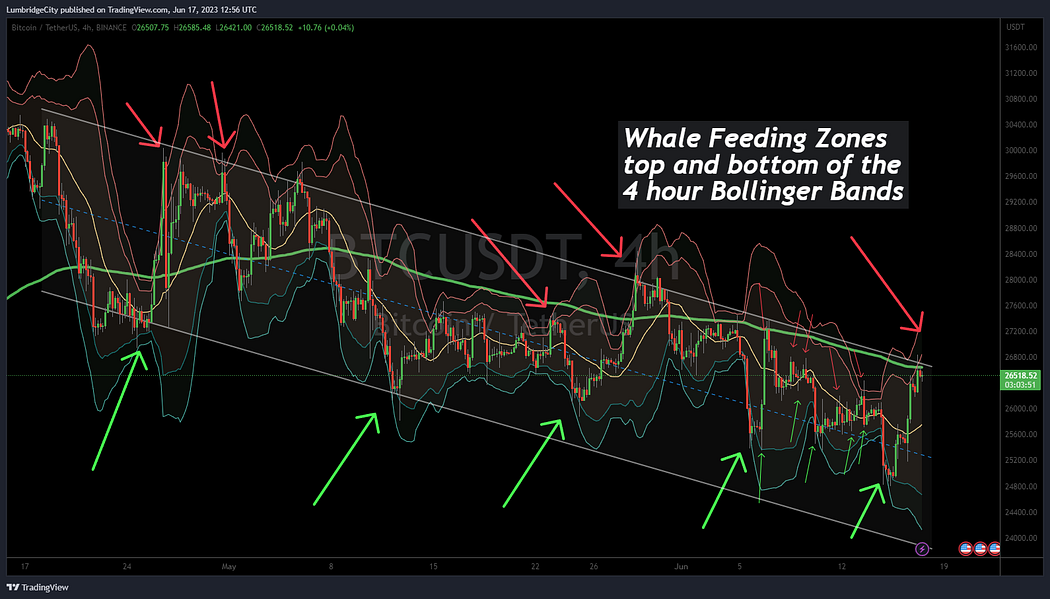Are you tired of the crypto market that seem to drain your wallet and your sanity? Here’s an insider’s guide on how to sail smoothly through the stormy waters of trading.
Unlock the Hidden Potential of Trading
Trading is a minefield of decisions, risks, and emotions. No matter how vigilant you are, one wrong move out of may good moves, and you can suddenly take a large, unexpected loss.
But what if you could pinpoint and correct trading errors, decode the market noise, and make decisions that didn’t need to have surgical precision?
It all boils down to two main aspects: making room for the market noise in your trading plan and with a position size that lets you manage emotions and your time.
Let’s deep dive into some of my recent trading mistakes to unveil the art of successful trading.
Demystifying Market Noise: The Shark and Whale Zones
Understanding the ebb and flow of market noise is essential. Are you ready to survive the sharks and the whales?
Market noise is the short-term price movements that may seem irrelevant when you look at the bigger picture. For the adept trader, market noise is like the range in which sharks and whales operate.
The Shark Feeding Zone is where price movement is within the one-hour Bollinger band range — the micro-term perspective.

Just outside of that is Whale Feeding Zone is where price movement is within the four-hour Bollinger band range, indicative of a short-term perspective.

Long Term Trend Within The Short Term Chop
The key is to recognize that micro-term and short-term perspectives might be different from long-term perspectives and might just be market noise.
There may not be a way to actually know when the price movement is just noise or if it is indicative of a larger trend change until after the fact… This is a critical truth of trading trends that must become part of how you place your trades, how you choose your position sizes, and how you follow your risk control rules.
The Power of Risk Control: The Golden Rules

Your trading plan is your best ally. Discover the two golden rules that will keep you afloat.
Your trading plan must have two components: entries and risk control rules. These risk control rules are your safeguard against the known, factual, expected unpredictability of the market.
Get This First: Forget Your Opinion
Once you surrender to the fact that your opinion is just a potential of what the market may do. Since unpredictability is so common, we simply have to forget about your opinion and get out of the position if it’s not proving you correct. This means you should not hold a position that neither validates nor contradicts your initial reading.
Rule Number Two: Start Small
Rule number two should be the first thing you learn. But most people need this lesson in practical terms before the words of the lesson will sink in.
In other words, you have to lose money doing this wrong for quite a while before you’ll begin to see the long term wisdom of this principle.
Rule number two directs us to to keep a small position until the market proves you right. The sideways market chop can be brutal when you are expecting to be correct. When we expect market chop instead, it feels natural to have a small position because that will allow you to weather the storm that you are expecting.
Navigating Emotions: The Calm During the Storm
Emotions can be your worst enemy. Learn how to stay calm and collected amid the turmoil.
Your emotional state has a direct impact on your trading effectiveness. Stress responses, triggered by various market uncertainties, can lead to impulsive decisions and derail your trading plan.
Trading with a small position and low leverage, and using money that you can afford to set aside, keeps your emotional state relaxed and your decision-making more sharp.
The Brain & Trading: A Double-edged Sword
Understand the connection between your brain and your trading success.
When stressed, your brain limits its cognitive abilities and relies more on subconscious habits. In trading, stress switches off the frontal cortex of your brain, causing reactions based on old emotional habits, often associated with how we viewed money as a child.
Wrapping It Up: The Path to Trading Success

Trading success is an art that combines understanding market noise, following risk control rules, and managing emotions. Master these, and watch your trading prowess soar.
By journaling your trades, being mindful of your emotional state, and religiously adhering to your risk control rules, you can improve your trading and scale up to larger sums of money.
The secret is simple — trade small enough that you can let the money work for you while you remain the calm captain navigating through the stormy market seas.
Your future successful trades will thank you for slowing down.



